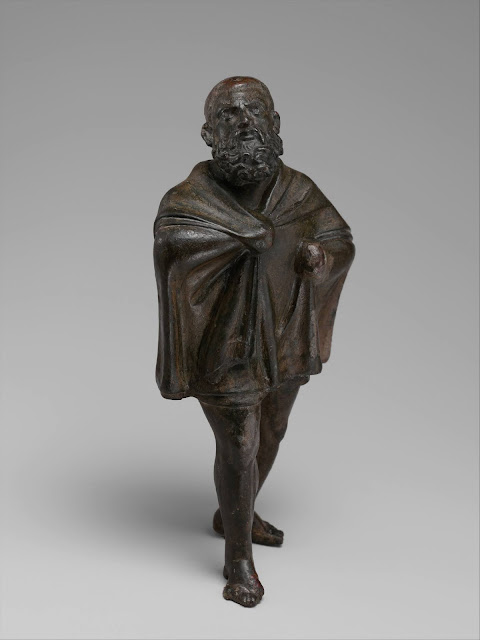Bronze statuette of a draped man thought to be an actor 1st century BCE - 1st century CE
This impressive statuette shows a mature, bearded man who stands purposefully and looks upward. The cloak that covers his torso also conceals his arms, bent forward over his chest. Proposed identifications have linked him with the theater, specifically as an actor declaiming a text rather than playing a role. - Metropolitan Museum of Art
Roman theater began to develop following the devastation of a widespread plague in 364 BCE. Roman citizens began including theatrical presentations as a supplement to the Lectisternium ceremonies, religious propitiatory meals, in a stronger effort to pacify the gods. In the years following the establishment of these practices, actors began adapting these dances and games into performances by acting out texts set to music and simultaneous movement.
As the era of the Roman Republic progressed, citizens began including professionally performed drama in the eclectic offerings of the ludi (celebrations of public holidays) held throughout each year—the largest of these festivals being the Ludi Romani, held each September in honor of the Roman god Jupiter. It was as a part of the Ludi Romani in 240 BCE that author and playwright Livius Adronicus became the first to produce translations of Greek plays to be performed on the Roman stage.
In the 1st century CE, Seneca, the famous Stoic philosopher and tutor to the emperor Nero, wrote tragedies that used a declamatory style emphasizing rhetoric. These works sought to reflect the soul of a tragic character by using rhetoric to reveal something about the state of the character's mind. One of the most notable ways that Seneca developed a tragedy, was through the use of an aside, a common theatre device in Hellenistic drama, but, at the time, foreign to the world of Attic tragedy. Seneca used 'self-representational soliloquies or monologues,' which focused on one's inner thoughts, the central causes of their emotional conflicts, their self-deception, as well as other varieties of psychological turmoil to dramatize emotion in a way that became central to Roman tragedy, distinguishing it from prior forms of Greek tragedy. Perhaps this figure represented a rhetorician in one of Seneca's dramas.
Of course one of the most eye-catching aspects of this figure is the very short tunic and cloak he wears. The length of a Roman tunic indicated the wearer's social status. Soldiers, manual workers, and even slaves usually wore tunics that reached to just a little above the knee. Actors, however, were considered "infamia," an official exclusion from the legal protections enjoyed by a Roman citizen that included corporal punishment, usually reserved for slaves. This lowly status is reflected in the length of this figure's garments.
Image: Bronze statuette of a draped man thought to be an actor, 1st century BCE - 1st century CE, Greek or Roman, courtesy of the Metropolitan Museum of Art.




Comments
Post a Comment